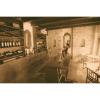
Listed building consent: is it worth it? By Simon Atha, Director, Boyer (part of Leaders Romans Group)
It is (undoubtedly) often said that there is nothing as charming or as quintessentially English as a beautifully preserved ancient pub. And yet for many within the hospitality industry, the idea of applying for listed building consent to revive an old pub will raise alarm bells.
In this article, I’ll explain how that process isn’t as complex and convoluted as some believe, and my experience of achieving listed building consent for the restoration of an ancient coaching inn.
Dating back to the 1300s, The Mitre is Oxford’s oldest pub. From the days of Chaucer, the Peasants’ Revolt and the Hundred Years war, people have been drinking on the site – initially in a cellar which is still intact today, and later in the 1630s inn built above it. Not only was The Mitre a Medieval drinking establishment, but it is said to have been used as one of the ancient centres of learning which eventually gave rise to the foundation of the University of Oxford.
So it was a disappointment to the city when the pub’s longstanding owners, Lincoln College, closed The Mitre in 2019. But this was necessary to undertake the substantial repairs and renovations to make it fit for continued use. With its stone fireplaces and panelling dating from the 1600s, stucco clad beam with a decorative pattern of exotic pomegranates (possibly dating from the previous century and moved on site), the inn not only has fascinating history but a history which is well-evidenced in its fabric.
In 2022 the building was acquired by Gusto Italian, which committed to a £1.4 million investment, both to preserve the listed features but also to introduce modern design elements unique to the brand. And dining in the Theatre Kitchen or the Dine Under the Olive Trees restaurants today, few would argue that the sensitive restoration has been a success.
A bureaucratic nightmare? Not really - listed building consent doesn’t need to be complex, even in the case of such a highly protected building. But to carry out unauthorised work is a criminal offence which can result in individuals being prosecuted and the work reversed, so it’s important to involve an experienced architect and planning consultant.
It is also important to bear in mind that the Department of Digital, Culture, Media and Sport’s criteria for listed buildings isn’t limited to specific buildings in isolation, or solely to bricks and mortar: in addition to ‘buildings of importance because of their design, decoration and craftsmanship’ other categories are buildings which ‘illustrate an aspect of the nation's social, economic, cultural or military history’, ‘demonstrate close historical association with nationally important people or events’ and ‘form part of an architectural ensemble, such as squares, terraces or model villages’: the context and the historical significance can result in a building be listed too.
Listed building consent is obtained though the local planning authority. Once the architect has drawn up the plans, the planning consultant will check whether or not it requires listed building consent and if it does, what the local authority regards as acceptable, which can vary considerably, and therefore whether the plans are likely to achieve consent.
As is frequently the case, the application for listed building consent for the Mitre was submitted along with a planning application for further structural works, with Boyer handling both.
A series of ‘pre-app’ meetings with the conservation office follow prior to the submission of the planning application. The period for determination should take no more than 13 weeks, but varies considerably due to the extent of negotiation with the conservation officer and the requirement for Historic England and other organisations to be consulted. Local residents are also informed and invited to comment.
In most cases, a well-managed listed building consent will be granted by council officers under delegated legislation, rather than doing to a planning committee. Generally speaking, local authorities are keen to see historic buildings brought back into use, their features retained and the building once again making a positive contribution to the built environment. If officers have been actively involved and their advice taken, the outcome is usually positive.
No applicant should feel that listed building consent exists only to preserve or reinstate an ancient building: the purpose of planning is to manage change. The system exists to enable historically significant buildings to continue to have a role, but it doesn’t require that role to replicate its original use precisely. As diners in Oxford’s new Italian restaurant will testify, thanks to changing tastes and trends, hospitality venues are destined to change over time, and the system exists to recognise and facilitate this.










